The 1854 & 1855 Women's Rights Conventions at St. Nicholas Hall
Introduction
Text-to-speech Audio
In August 1854 Susan B. Anthony, joined by Matilda Joslyn Gage and Sarah Pellet, organized a convention on women's rights held at St. Nicholas Hall. With the success of the 1854 event, a second Saratoga convention was organized for August 15-16, 1855, also at St. Nicholas Hall. The original St. Nicholas Hall no longer stands; it was changed to Putnam Music Hall in the 1880s, but the building was destroyed in one of the several fires that plagued Saratoga in the nineteenth century.
Images
Susan B. Anthony, 1848
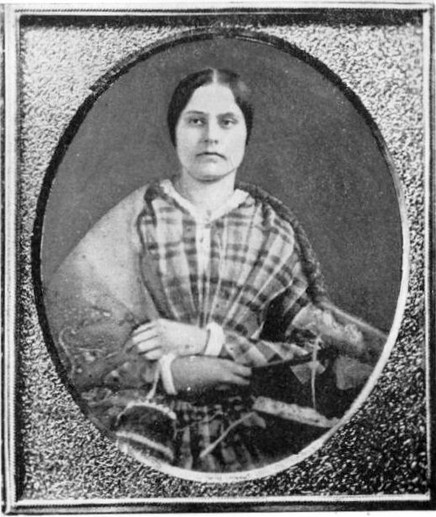
Matilda Joslyn Gage, engraving by John Chester Buttre
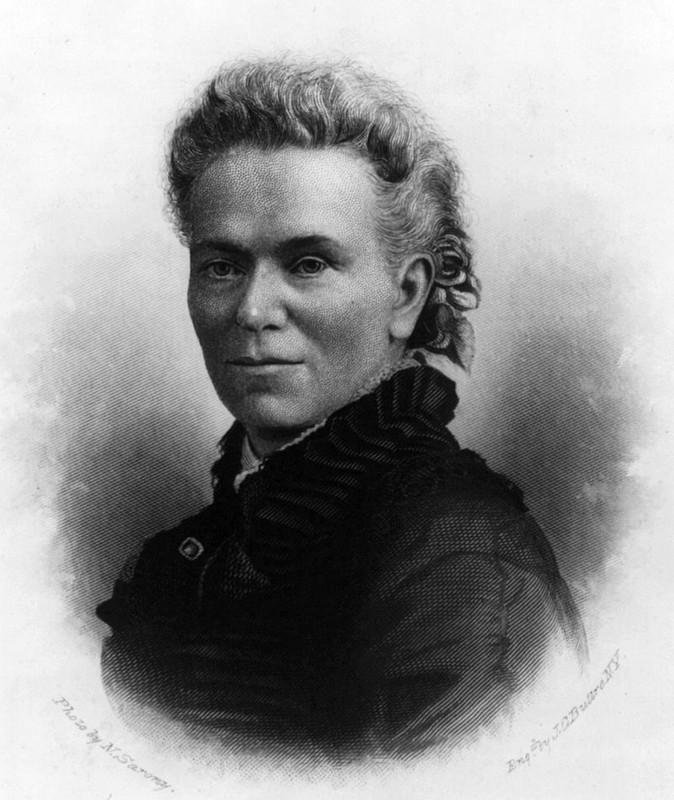
Martha C. Wright presided as chair over the 1855 convention
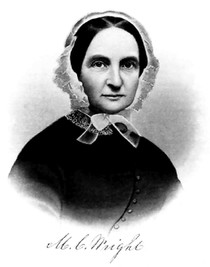
Ernestine L. Rose spoke at the 1855 convention
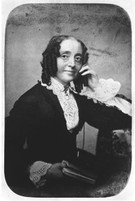
Antoinette Brown spoke at the 1855 convention, and was called upon to discuss Biblical arguments against suffrage as she was a preacher in the Congregational Church.
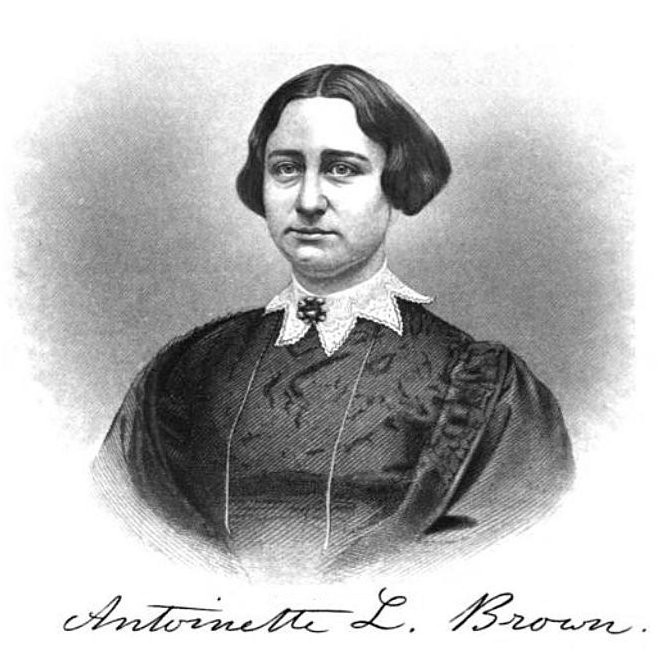
Samuel J. May, abolitionist and supporter of women's rights, addressed the 1855 convention.
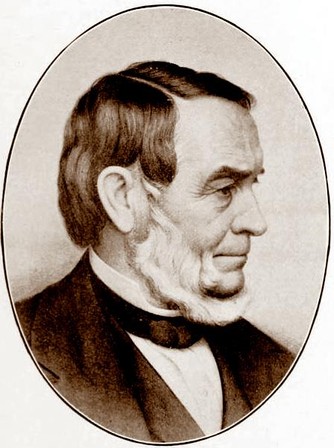
Mary L. Booth was mentioned in the synopsis of the 1855 convention
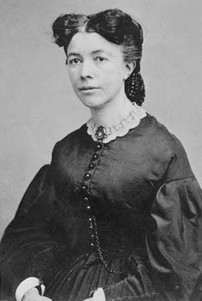
Thomas Wentwoth Higginson addressed the 1855 convention.
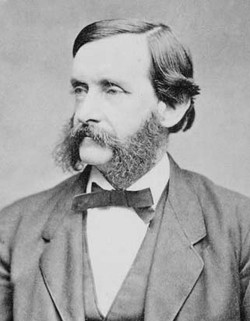
Lucy Stone attended a portion of the 1855 convention.
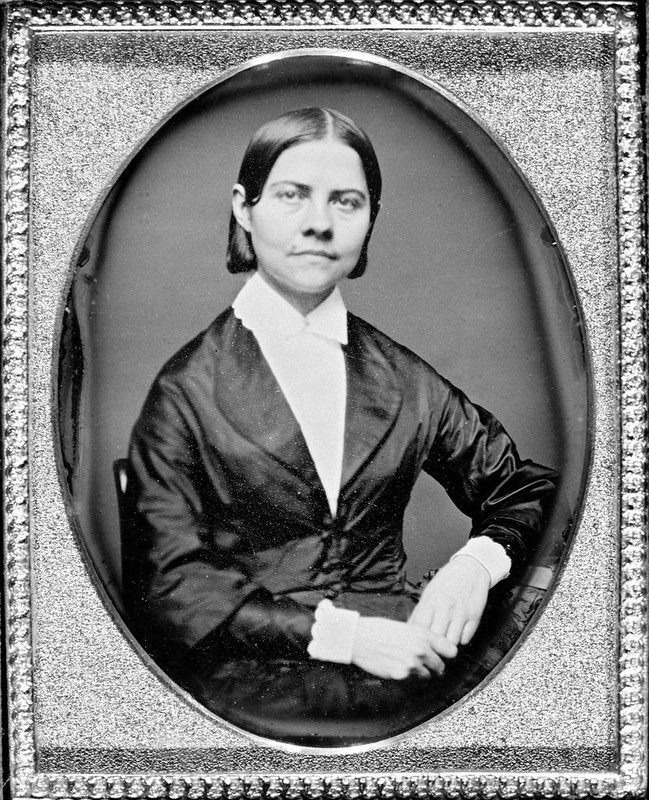
Section of 1850s map showing the Putnam Block along Broadway with Phila Street ending at Putnam Place.
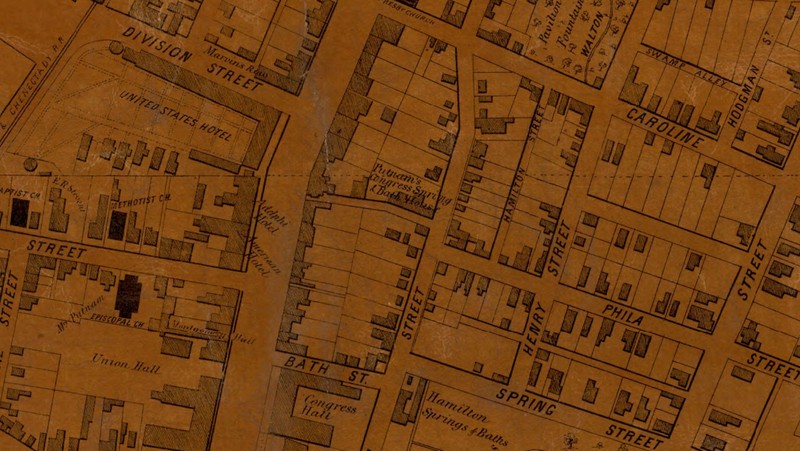
Full 1850s map of Saratoga Springs, NY
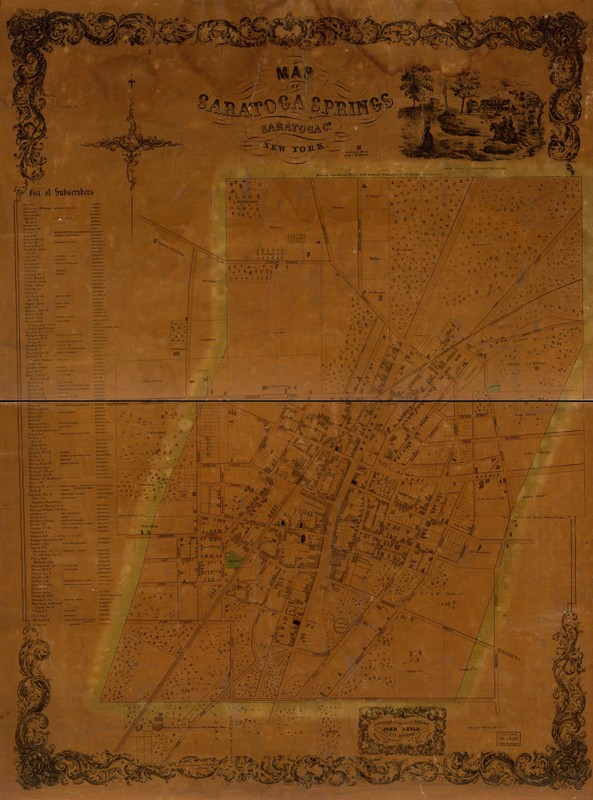
In the 1871 Gazetteer and Business Directory, the Saratogian advertised its location in the St. Nicholas Building at Broadway and Phila Streets. (page 224)
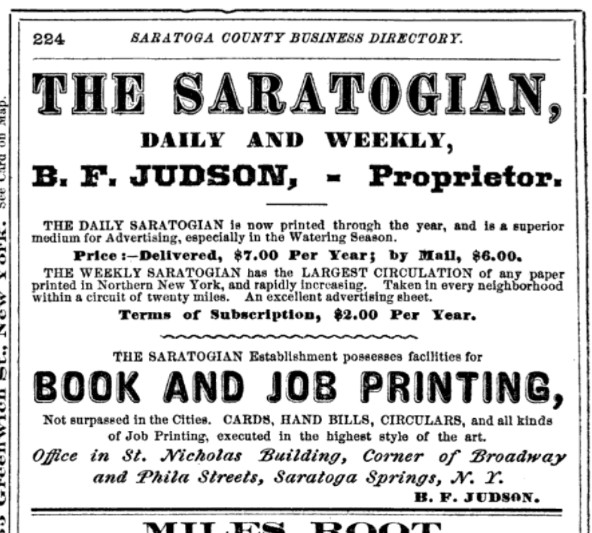
Section of 1874 panorama map--Putnam Music Hall is likely the building with the word "Post" on it
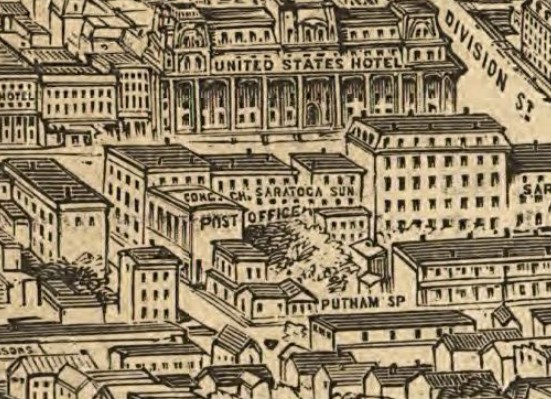
Panoramic map of Saratoga Springs, 1874: "Saratoga Springs and vicinity : scene of the inter-collegiate regatta"
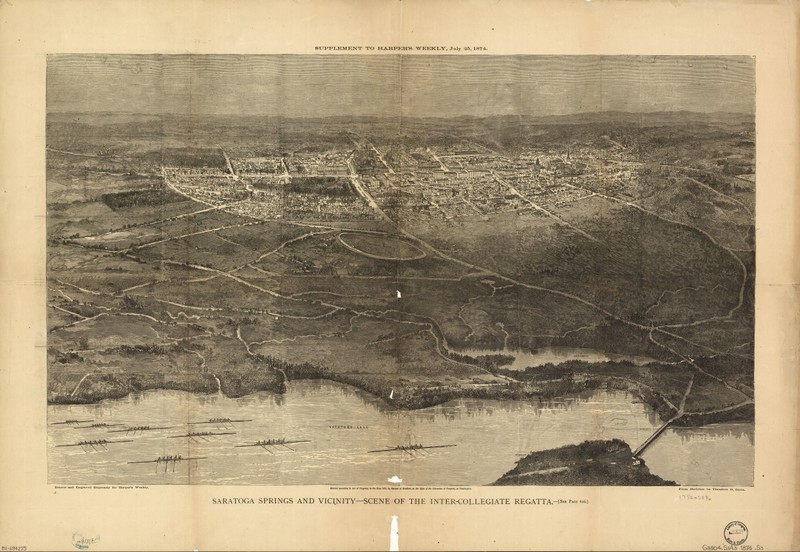
Section of the June 1884 Sanborn Fire Insurance Map shows the newly renamed Putnam's Music Hall as well as the Daily Saratogian.
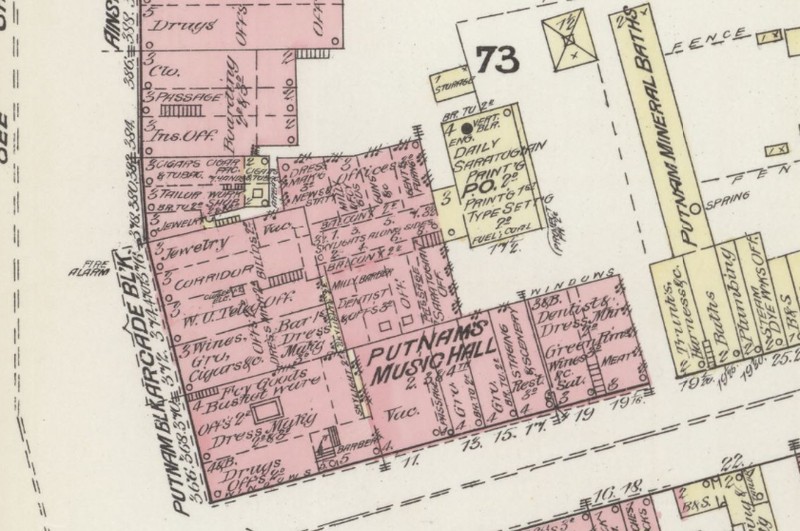
Section of 1888 panorama map--Putnam Music Hall is likely the building with the large arches.
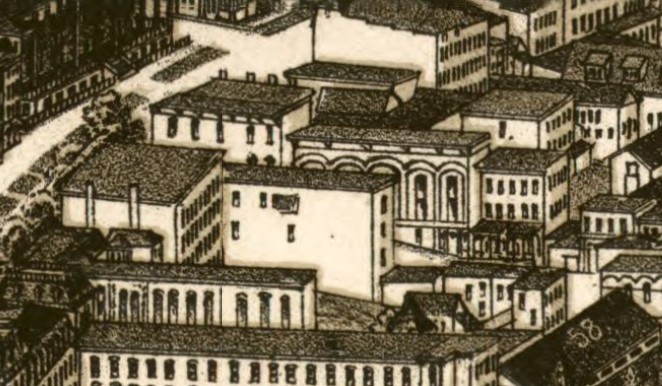
Panoramic map of Saratoga Springs, 1888
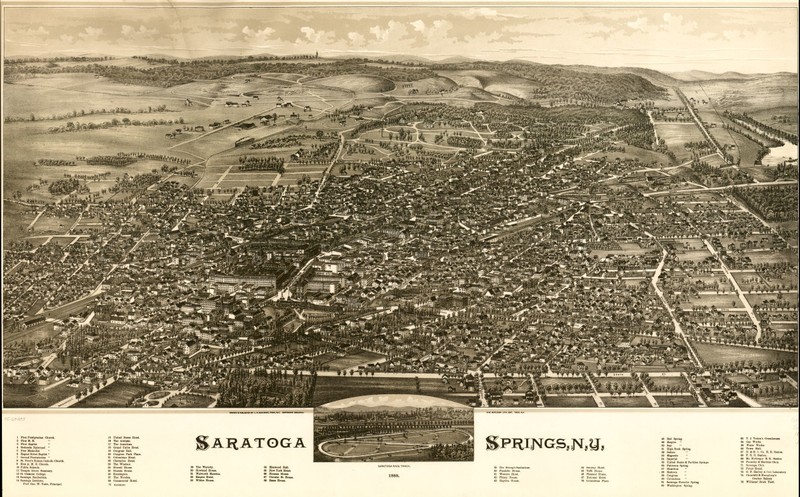
Section of the October 1889 Sanborn Fire Insurance Map showing Putnam Music Hall.
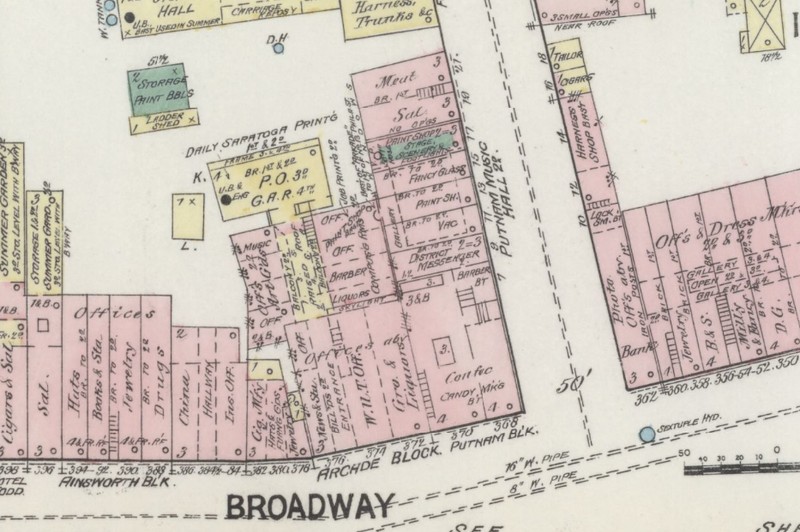
Section of the May 1895 Sanborn Fire Insurance Map showing Putnam Music Hall.
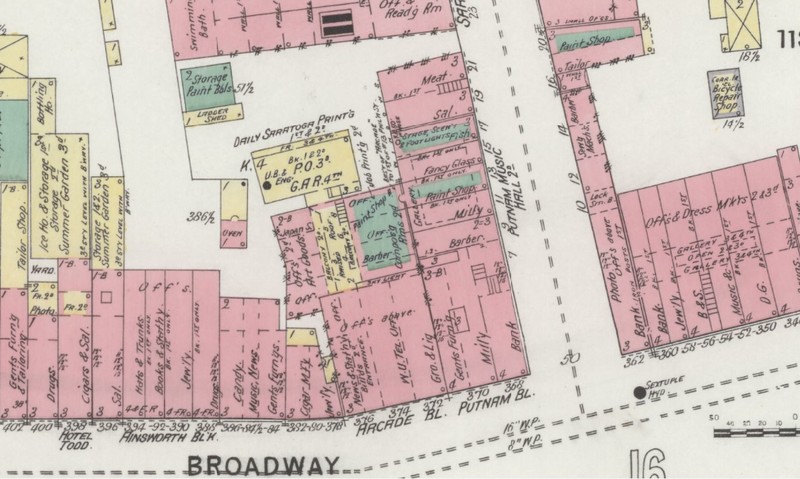
In the 1900 Sanborn Map Putnam Music Hall has been renamed the Saratoga Theatre.
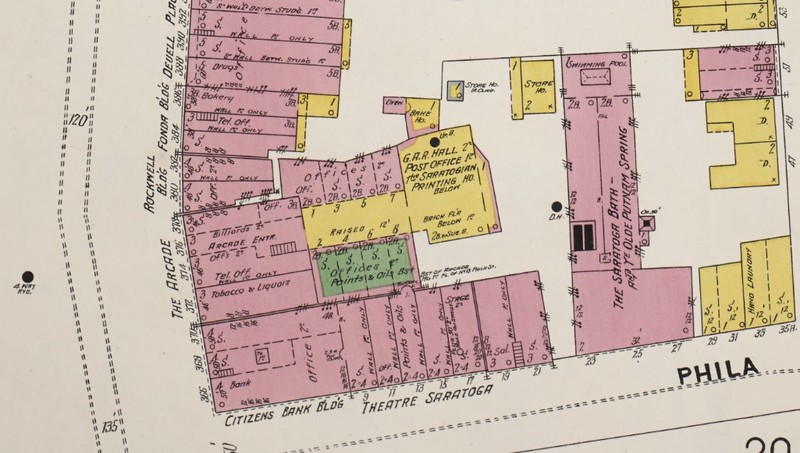
Aftermath of the 1902 Arcade fire
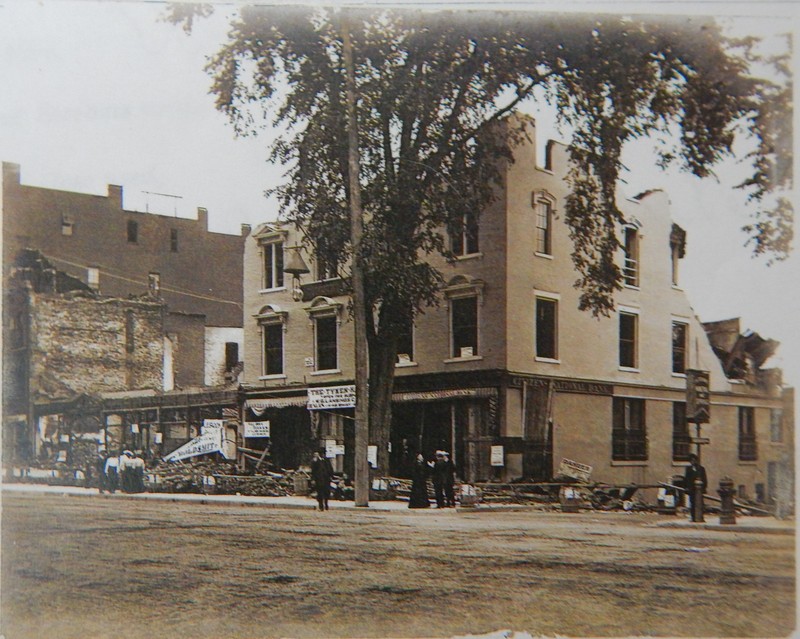
Circa 1950 Sanborn Fire Insurance Map (section) shows the reconstruction after the 1902 Arcade Fire.
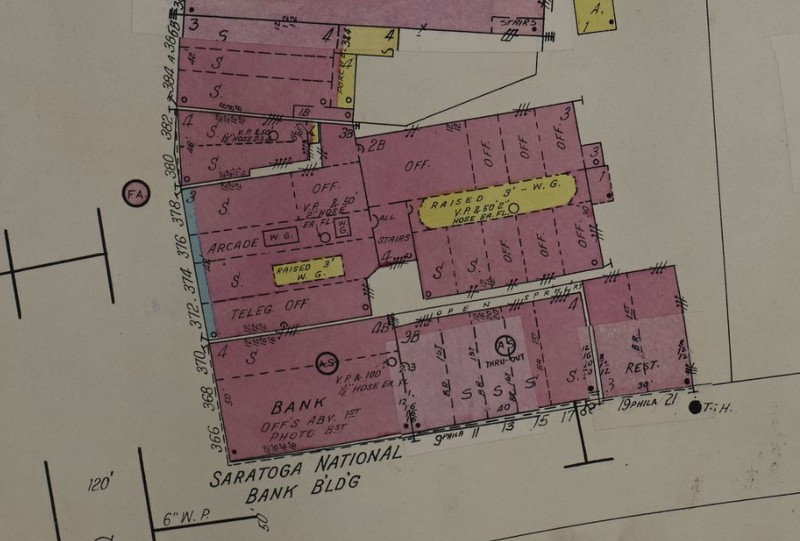
Backstory and Context
Text-to-speech Audio
Nancy Putnam Andrews owned the block in the 1800s and constructed the entertainment hall known as St. Nicholas Hall likely in the area of 368 Broadway. The Saratogian notes that St. Nicholas Hall was constructed on the corner of Broadway and Phila Streets, although in the 1850s Phila Street stopped at Putnam Street and did not go through to Broadway. In 1865 there was a fire that burned a number of buildings between Broadway and Putnam Streets. It is not clear whether the fire affected St. Nicholas Hall, but after the fire Phila Street was extended to Broadway. It appears that Abel Putnam purchased St. Nicholas Hall in 1878, after which it was renamed Putnam Music Hall in the early 1880s. In 1884, Putnam Music Hall was listed as a 600-seat theater with a 26 x 17 stage. Putnam Music Hall was destroyed by a fire in April 1896 according to a report in The Cultivator & Country Gentleman of April 9, 1896. The theater was rebuilt and renamed the Saratoga Theater, but the whole section of the block burned in 1902 in the famous Arcade Fire. The Citizens National Bank building was reconstructed after the 1902 fire, and was later renamed the Saratoga National Bank.
Account of the 1854 & 1855 women's rights conventions, from History of Woman Suffrage, Volume I, pages 620-626:
“Saratoga Conventions
August, 1854-‘55
Seeing calls for two national conventions, by the friends of Temperance, and the Anti-Nebraska movement, to be held in Saratoga the third week of August, the State Woman Suffrage Committee decided to embrace that opportunity to hold a convention there at the same time.1 As it was at the height of the fashionable season it was thought much good might be accomplished by getting the ear of a new class of hearers.
But after the arrangements were all made, and Miss Anthony on the ground, she received messages from one after another of the speakers on whom she depended, that none of them could be present. Accordingly, encouraged by the Hon. William Hay, she decided to go through alone. Happily, Matilda Joslyn George and Sarah Pellet being in Saratoga, came forward and volunteered their services, and thus was the Convention carried successfully through.2 The meeting was held in St. Nicholas Hall, which was well filled throughout, three hundred dollars being taken at the door. The following resume of this occasion is from the pen of Judge Willian Hay, in a letter to The North Star of Rochester (Frederick Douglas, editor):
The Saratoga Convention
Miss Sarah Pellet addressed an audience of six hundred persons in the afternoon, most of whom returned with others to St. Nicholas Hall in the evening, thus manifesting their satisfaction with what they had heard and their interest in the cause, which was further discussed by Mrs. Gage, whose address was an elaborate argument for the removal of woman’s legal and social disabilities. Among other authorities she quoted with judgement, was the following from Wm. W. Story: “In respect to the powers and rights of married women, the law is by no means abreast the spirit of the age. Here are seen the old fossil prints of feudalism. The law relating to woman tends to make every family a barony, a monarchy, or a despotism, of which the husband is the baron, king, or despot, and the wife the dependent, the serf, or slave. That this in not always the fact, is not due to the law, but to the enlarged humanity which spurns the narrow limits of its rules; for if the husband choose, he has his wife as firmly in his grasp and dominion, as the hawk has the dove upon whom he has pounced. This age is ahead of the law. Public opinion is a check to legal rules on this subject, but the rules are feudal and stern, It can not, however, be concealed that the position of woman is always the criterion of the freedom of a people or an age, and when man shall despise that right which is founded only on might, women will be free to stand on an equal level with him—a friend and not a dependent.”
Mrs. Gage also, and with like effect, cited from the same learned jurist, laws, which, had her lecture been a sermon, might have be prefixed as a text. Such opinions, although but seldom known to any but lawyers, and not appreciated by many of them, have frequently been printed in books, which, however, being professional, are perused by few persons only. Mrs. Gage3 concluded her excellent discourse with Bryant’s celebrated stanza, relative to truth and error.
Miss Anthony’s situation had become embarrassing, if not critical. At a late hour of a summer night, she was to follow Mrs. Gage on the same subject, and before a fastidious audience, almost surfeited during three days with public addresses in several different conventions, and many of whom desired to contrast her expected effort with the splendid platform eloquence of Henry J. Raymond, Wm. H. Burleigh, and “their like,” fearlessly advocating the redress of wrongs and the promotion of human rights. Miss Anthony, who had conciliated her audience by lady-like conduct and courtesy, in providing seats for the accommodation of those standing, commenced with an appropriate apology for unavoidable repetition, when it was her lot to follow Mrs. Gage. Sufficient here to say that she acquitted herself admirably. The simplicity and repose of her manner, the dignity of her deportment, the distinctiveness of her enunciation, her empathetic earnestness, the pathos of her appeals, and completeness of her arguments, convinced the understanding and persuaded all hearts.
The gossip of mustached dandies, and the half-suppressed giggles of bedizened beauty, soon settled down into respectful attention, if not appreciated. Indeed many of the most intelligent hearers before retiring, audibly confessed that they had came to find fault, but had seen nothing to censure. So some who came to scoff remained to applaud. With such advocates there can be no retrogression of Woman’s Right. Equality is their motto, and onward their destiny.
Wm. Hay
This Convention was so successful in point of numbers and receipts, and the sale of woman suffrage literature, that it was decided to repeat the experiment the next year; accordingly the following call was issued early in the season:
Saratoga Convention, 1855
A Convention will be held at Saratoga Springs on the 15th and 16th of August next, to discuss woman’s right to suffrage.
In the progress of human events, woman now demands the recognition of her civil existence, her legal rights, her social equality with man.
How her claims can be the most easily and speedily established on a firm, enduring basis, will be the subject of deliberation at the coming Convention.
The friends of the movement, and the public generally, are the most respectfully invited to attend.
Many of the advocates of the cause are expected to be in attendance.
Elizabeth Cady Stanton,
Ernestine L. Rose.
Samuel J. May,
Lydia Mott,
Antoinette L. Brown,
Susan B. Anthony
This Convention also was held in St. Nicholas Hall, and a large audience greeted the speakers of the occasion as they appeared upon the platform.
A brief report of the secretaries in The Una of September, 1855, says: A large audience assembled on the morning of August 15th at St. Nicholas Hall. Susan B. Anthony called the meeting to order, and presented a list of officers4 nominated at a preliminary gathering, which was accepted. Martha C. Wright, on taking the chair made a brief statement of the object of the Convention, and invited all those who were opposed to our demands to come to the platform and state their objections.
During the absence of the Business Committee, Ernestine L. Rose briefly reviewed the rise and progress of the woman’s rights movement. Antoinette Brown reported a series of resolutions, on which she commented at some length, when the Rev. Samuel J. May was introduced. Although he spoke to the entire edification of the platform, yet he was constantly interrupted by the audience. It was a novelty to hear women speak, and the audience having assembled for that purpose, preferred to listen to woman’s pathetic statements of her wrongs, than to the most gifted orators that men could boast. It was not until after repeated requests for order from the president, and assurances from several of the ladies that they would not speak until Mr. May had finished his remarks, that quiet was restored.
It was at this Convention that Mary L. Booth5 made her first appearance on our platform, as one of the secretaries. One feature of these meetings was the freedom and warm sympathy between the audience and the platform. At the close of almost every speech, some one on the floor asked questions and refuted by the speakers in the most pleasant conversational manner.
Mrs. Rose presented the wrongs of woman in her most happy manner, demanding the ballot as the underlying power to protect all other rights. Thomas Wentworth Higginson made an address specially adapted to the fashionable audience. Many of the thoughtless ones whom idle curiosity had led to the hall, must have felt like the woman of Samaria (John iv. 29) at the well, when she reported that she had seen a man who told her all the things that ever she had done, so nearly did Mr. Higginson picture to them their thoughts and feelings, the ennui of their daily lives. Lucy Stone, whom the papers now call Mrs. Blackwell, arriving in the midst of the convention, was greeted with long and repeated cheers, and spoke with her wonted simplicity and earnestness. The resolutions covering all the different phases of the movement were duly discussed through two entire days.
Antoinette Brown was called on as usual to meet the Bible arguments. A clergyman accused her of misapplying texts. He said Genesis iv. 7 did not allude to Cain and Abel, and that the language in Genesis iii. 16, as applied to Eve, did not mean the same thing. Miss Brown maintained her position that the texts were the same in letter and spirit; and that authority to all men over all women could be no more logically inferred from the one, than authority to all elder brothers over the younger could be from the other; and that there was no divine authority granted in either case.
Miss Anthony announced that woman’s rights tracts and papers were for sale at the door, and urged all who had become interested in the subject to procure them not only for their own benefit, but to circulate among their neighbors. If they would be intelligent as to the real claims of the movement, they must take The Una, a paper owned and edited by one of its leaders. No one would expect to get temperance truths from Bennett’s Herald, not anti-slavery facts from The New York Observer, or Christian Advocate; no more can we look to any of the popular newspapers, political or religious, for reliable information on the woman’s rights movement.
She also presented the claims of The Woman’s Advocate, a paper just started in Philadelphia by Anna E. McDowell, devoted chiefly to woman’s right to work—equal pay for equal service (she was sorry that it did not see that the right of suffrage underlies the work problem); nevertheless the existence of a paper owned, edited, published, and printed all by women, was a living woman’s rights fact, and she hoped every one would give it encouragement and support. She then gave a brief report of the work done in the State during the past year,6 and closed by presenting the form of petition that had just been adopted.7
Mr. May moved the appointment of a committee of five8 to engage lecturing agents and raise funds for their compensation. The president thanked the people for the respect and attention manifested during the several sessions, and adjourned the Convention.9
The Saratoga papers were specially complimentary in their notices of Ernestine L. Rose and Lucy Stone, pronouncing them logical and eloquent, and Miss Anthony was highly praised for her skill in getting contributions and distributing documents. She sold over twenty thousand pamphlets that year. As there were many Southern people always at Saratoga, this was considered a grand opportunity through tracts to sow the seeds of rebellion all through the Southern States. This Convention afforded a new theme for conversation at the hotels, and was discussed for many days after with levity or seriousness, to be laughed over and thought over by the women at their leisure.10
1. As this meeting was hastily decided upon, there was no call issued; it was merely noticed in the county papers. The Saratoga Whig, August 18, 1854, says:
WOMEN’S RIGHTS—The series of conventions that have been holding sessions in the village during the week, will close this day with a meeting for the discussion of the social, legal, and political rights of women, at which Miss Susan B. Anthony, Mrs. Matilda Joselyn Gage, and Miss Sarah Pellet will appear, The meetings will be held at St. Nicholas Hall this afternoon at 31/2 o’clock, and in the evening at 8 o’clock.
2. Any one but the indomitable Susan B. Anthony would have abandoned all idea of a meeting, but, as it was advertised, she felt bound to make it a fact. This decision may seem the more remarkable in view of other facts, that Miss Anthony had but little experience as a speaker, and was fully aware of her deficiencies in that line; her forte lay in planning conventions, raising money, marshalling the forces, and smoothing the paths for others to go forward, make the speeches, and get the glory. Having listened in St. Nicholas Hall for several days to some of the finest orators in the country, it was with great trepidation that she resolved to attempt to hold such audiences as had crowded all the meetings during the week, and would no doubt continue to do so. However, she had one written speech, which she decided to divide, giving the industrial disabilities of women in the afternoon, and their political rights in the evening, supplementing each with whatever extemporaneous observations might strike her mind as she proceeded. With Mrs. Gage to speak at one session and Miss Pellet at the other, Miss Anthony rounded out both meetings to the general satisfaction. It was thus that she always stood ready for every emergency; when nobody else would or could speak she did; when everybody wished to speak she was silent.—E.C.S.
3. The Daily Saratogian, August 19th, said: Mrs. Matilda Joslyn Gage, a medium-sized, lady-like looking woman, dressed in a tasty plum-colored silk with two flounces, made the first address upon some of the defects in the marriage laws, quoting Story, Kent, and Blackstone. She closed by speaking of Mrs. Marcet, an able writer on political economy, her book much used in schools. She referred to Miss Pinckney, of South Carolina, who in nullification times, wrote powerfully on that subject. It was said that party was consolidated by the nib of a lady’s pen. She was the first woman in the United States who was honored with a public funeral.
4. President—Martha C. Wright, of Auburn
Vice-Presidents—Rev. Samuel J. May, Syracuse; Lydia Mott, Albany; Ernestine L. Rose, New York; Antoinette L. Brown, New York; Susan B. Anthony, Rochester; Augusta A. Wiggins, Saratoga Springs
Secretaries—Emily Jaques, Nassau; Aaron M. Powell, Ghent; Mary L. Booth, Williamsburgh
Finance Committee—Susan B. Anthony, Marietta Richmond, Mary S. Anthony, Phebe H. Jones
Business Committee—Antoinette L. Brown, Ernestine L. Rose, T.W. Higginson, Charles F. Hovey, of Boston; Phebe Merritt, of Michigan; How. William Hay, of Saratoga Springs
5. Now the successful editor of Harper’s Bazar.
6. This year Miss Anthony canvassed the State, holding conventions in fifty-four counties, organizing societies, getting signatures to petitions, and subscribers to The Una. At some of these meetings Mrs. Rose, Miss Brown, and Miss Filkins assisted by turn, but the chief part she carried through alone. She had posters for the entire State printed in Rochester, her father, brother Merritt, and Mary Luther folding and superscribing to all the postmasters and the sheriff of every county. The sheriffs, with but a few exceptions, opened the Court Houses for the meetings, posted the bills, and attended to the advertising. Miss Anthony entered on this work without the pledge of a dollar. But with free meetings and collections in the afternoon, and a shilling admission in the evening, she managed to cover the entire expense of the campaign.
7. WOMEN’S RIGHTS PETITION
To the Honorable, the Senate, and Assembly of the State of New York:
WHEREAS, the women of the State of New York are recognized as citizens by the Constitution, and yet are disfranchised on account of sex; we do respectfully demand the right of suffrage; a right which involves all other rights of citizenship, and which can not be justly withheld, when we consider the admitted principles of popular government, among which are the following:
1st. That all men are born free and equal.
2nd. That government derives its just powers from the consent of the governed.
3rd. That taxation and representation should go together.
4th. That those held amenable to laws should have a share in framing them.
We do, therefore, petition that you will take the necessary steps so to revise the Constitution of our State, as that all her citizens may enjoy equal political privileges.
8. The committee were Susan B. Anthony, Ernestine L. Rose, Antoinette L. brown, Elizabeth Cady Stanton, Martha C. Wright, Lydia Mott.
9. At the close of this Convention, Charles F. Hovey, as was his usual custom, planned an excursion for those who had taken part in the meeting. He invited them to take a drive to the lake, a few miles out of Saratoga, gave them a bountiful repast, and together they spent a day rich in pleasant memories. Listening day after day to the wrongs perpetrated on women by law and Gospel of man’s creation, Mr. Hovey always seemed to feel that he was in duty bound to throw what sunshine and happiness he could into the lives of women, and thus in a measure atone for the injustice of his sex, and most royally he did this whenever an opportunity offered, not only while he lived, but by bequest at his death.
10.Twenty years after this Mrs. Stanton met a lady in Texas, who told her about this Saratoga Convention. She said her attention was first called to the subject of woman’s rights by some tracts a friend of hers, then living in Georgia, brough home at that time, and that we could form by little idea of the intense interest with which they were read and discussed by quite a circle of ladies, who plied her aunt with innumerable questions about the Convention and the appearance and manner of the ladies who led the movement.
Cite This Entry
Thompson, Kathleen. "The 1854 & 1855 Women's Rights Conventions at St. Nicholas Hall." Clio: Your Guide to History. January 4, 2022. Accessed April 1, 2025. https://theclio.com/entry/144287
Sources
“Bit of History on 368 Broadway.” Impressions of Saratoga/The Dark Horse Mercantile. March 10, 2018. Accessed January 4, 2022. https://www.impressionssaratoga.com/blog/bit-of-history-on-368-broadway/.
Dimopoulos, Thomas. “In the news 150 years ago.” The Saratogian. February 20, 2005. Accessed January 4, 2022. https://www.saratogian.com/2005/02/20/in-the-news-150-years-ago/.
“Fires.” (page 294) The Cultivator & Country Gentleman, Devoted to The Practice and Science of Agriculture and Horticulture at Large, and to all the various Departments of Rural and Domestic Economy. Vol. LXI---for 1896. Albany, NY: Published by Luther Tucker & Son, 395 Broadway. Accessed January 4, 2022. https://books.google.com/books?id=E7xAAQAAMAAJ&printsec=frontcover&source=gbs_ge_summary_r&cad=0#v=onepage&q&f=false.
Huffman, Olivia, and James Kettlewell. “360 Broadway: Architecture and History of Saratoga.” Architecture and History of Saratoga blog series. November 29, 2019. Accessed January 4, 2022. https://www.linkedin.com/pulse/360-broadway-architecture-history-saratoga-olivia-huffman?trk=portfolio_article-card_title.
Miner, Harry, ed. Harry Miner’s American Dramatic Directory for the Season of 1884-’85. A complete Directory of the Dramatic and Operatic Professions and a Guide to the Opera Houses, Theatres and Public Halls of America. New York: Wolf & Palmer Dramatic Publishing Company, 1884. Accessed January 4, 2022. https://books.google.com/books?id=VMo6AQAAIAAJ&printsec=frontcover&source=gbs_ge_summary_r&cad=0#v=onepage&q&f=false.
Patch, Ron. “Abel Putnam Jr.” Local History by Ron Patch. The Vermont Journal. April 29, 2020. Accessed January 4, 2022. https://vermontjournal.com/ron-patch/abel-putnam-jr/.
Stanton, Elizabeth Cady, Susan B. Anthony, and Matilda Joslyn Gage, ed. History of Woman Suffrage, In Three Volumes, Vol. I. Rochester, NY: Charles Mann, 1889.
"Susan B. Anthony." Wikipedia. Accessed January 4, 2022. https://en.wikipedia.org/wiki/Susan_B._Anthony.
"Matilda Joslyn Gage." Wikipedia. Accessed January 4, 2022. https://en.wikipedia.org/wiki/Matilda_Joslyn_Gage.
"Martha Coffin Wright." Wikipedia. Accessed January 4, 2022. https://en.wikipedia.org/wiki/Martha_Coffin_Wright.
"Ernestine Rose." Wikipedia. Accessed January 4, 2022. https://en.wikipedia.org/wiki/Ernestine_Rose.
"Antoinette Brown Blackwell." Wikipedia. Accessed January 4, 2022. https://en.wikipedia.org/wiki/Antoinette_Brown_Blackwell.
"Samuel Joseph May." Wikipedia. Accessed January 4, 2022. https://en.wikipedia.org/wiki/Samuel_Joseph_May.
"Mary Louise Booth." Wikipedia. Accessed January 4, 2022. https://en.wikipedia.org/wiki/Mary_Louise_Booth.
"Thomas Wentworth Higginson." Wikipedia. Accessed January 4, 2022. https://en.wikipedia.org/wiki/Thomas_Wentworth_Higginson.
"Lucy Stone." Wikipedia. Accessed January 4, 2022. https://en.wikipedia.org/wiki/Lucy_Stone.
Bevan, John. Map of Saratoga Springs, Saratoga Ct., New York. [New York: John Bevan, 185-?] Map. https://www.loc.gov/item/2001620479/. Accessed January 4, 2022.
Bevan, John. Map of Saratoga Springs, Saratoga Ct., New York. [New York: John Bevan, 185-?] Map. https://www.loc.gov/item/2001620479/. Accessed January 4, 2022.
Gazetteer and Business Directory or Saratoga County, N.Y., and Queensbury, Warren County, for 1871. Compiled and Published by Hamilton Child. Syracuse: Printed at the Journal Office, 23 & 24 E Washington Street, 1871. Accessed January 4, 2022. https://books.google.com/books?id=UFcVAAAAYAAJ&source=gbs_navlinks_s.
Davis, Theodore R, and Harper & Brothers. Saratoga Springs and vicinity: scene of the inter-collegiate regatta: see page 626. [New York City?: Harper & Brothers, 1874] Map. https://www.loc.gov/item/83694275/. Accessed January 4, 2022.
Davis, Theodore R, and Harper & Brothers. Saratoga Springs and vicinity: scene of the inter-collegiate regatta: see page 626. [New York City?: Harper & Brothers, 1874] Map. https://www.loc.gov/item/83694275/. Accessed January 4, 2022.
Burleigh, L. R. , 1853?-1923, and Burleigh Litho. Saratoga Springs, N.Y. [Troy, N.Y, 1888] Map. https://www.loc.gov/item/75694893/. Accessed January 4, 2022.
Burleigh, L. R. , 1853?-1923, and Burleigh Litho. Saratoga Springs, N.Y. [Troy, N.Y, 1888] Map. https://www.loc.gov/item/75694893/. Accessed January 4, 2022.
Sanborn Fire Insurance Map from Saratoga, Saratoga County, New York. Sanborn Map Company, Oct, 1889. Map. https://www.loc.gov/item/sanborn06240_002/. Accessed January 4, 2022.
Sanborn Fire Insurance Map from Saratoga, Saratoga County, New York. Sanborn Map Company, May, 1895. Map. https://www.loc.gov/item/sanborn06240_003/. Accessed January 4, 2022.
Sanborn Fire Insurance Map from Saratoga, Saratoga County, New York. Sanborn Map Company, 1900. Map. https://www.loc.gov/item/sanborn06240_004/. Accessed January 4, 2022.
“Bit of History on 368 Broadway.” Impressions of Saratoga/The Dark Horse Mercantile. March 10, 2018. Accessed January 4, 2022. https://www.impressionssaratoga.com/blog/bit-of-history-on-368-broadway/.
Sanborn Fire Insurance Map from Saratoga, Saratoga County, New York. Sanborn Map Company, - Apr 1950, 1950. Map. https://www.loc.gov/item/sanborn06240_005/. Accessed January 4, 2022.

